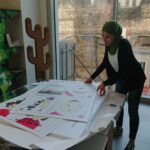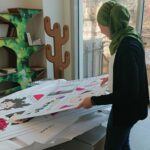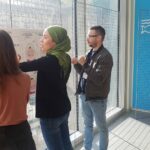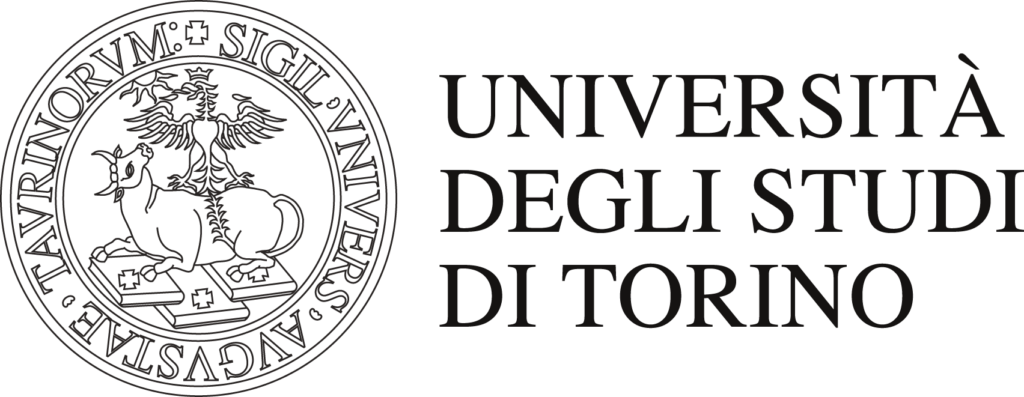



Presentazione libro
L'incontro

ANZAAR
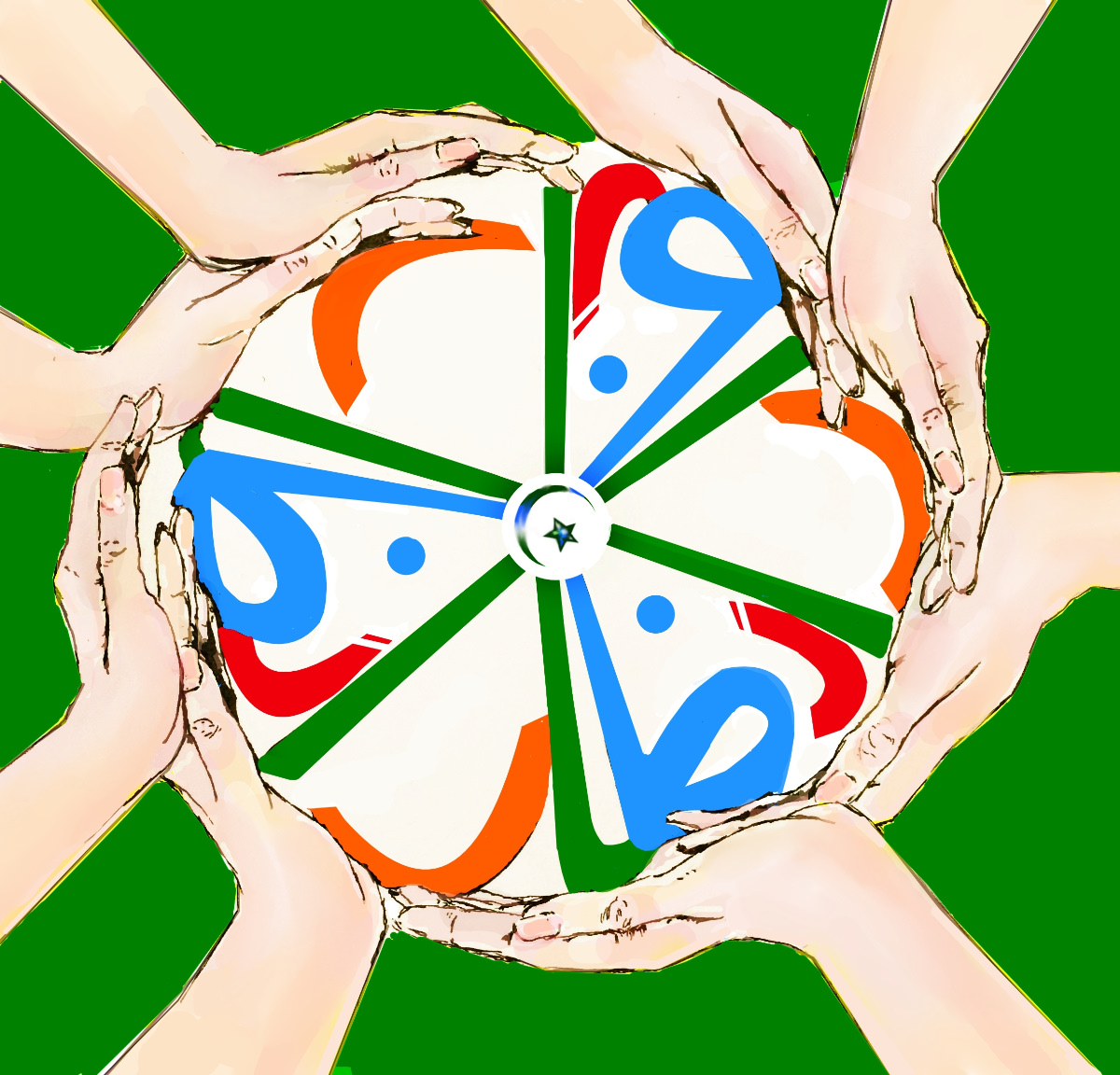
Partendo dal focus del progetto Primed, le artiste Paola de Ruggieri e Miriam Zatari hanno sviluppato un’idea di Samia Makhloufi e hanno realizzato il logo Anẓār con cui abbiamo diffuso l’iniziativa (sia la mostra, sia il seminario). Lo scopo era quello di sintetizzare con un’opera grafica il contenuto del workshop e ogni particolare è quindi frutto di una riflessione alla quale tutte abbiamo partecipato e di cui presentiamo qui i punti fondamentali. Prima di tutto abbiamo deciso di usare i caratteri arabi. Questo non solo perché la parola Anzaar che designa il gruppo e il seminario è una parola araba (in italiano “sguardi”), ma soprattutto perché la calligrafia è l’arte che più di ogni altra caratterizza la civiltà arabo-islamica sia nel passato sia nel presente. Come terzo, ma non trascurabile, motivo, infine, i caratteri arabi sono stati scelti perché la passione per lingua araba è l’elemento unificante del gruppo stesso, che è appunto composto esclusivamente da arabiste.
Nel logo, la parola Anzaar, “sguardi” è ripetuta in senso orario e ruota attorno a un tondo centrale nel quale confluiscono (o dal quale hanno origine) le lettere più alte e che racchiude una mezzaluna e una stella, cioè due noti simboli della cultura arabo-islamica. In tal modo si vuole sottolineare che gli “sguardi” in questione possono essere di due tipi: sia quelli che, partendo dall’esterno, convergono verso questa cultura, sia quelli che, partendo dal centro, in questa cultura hanno origine. A fare da cornice sono otto mani unite in cerchio: le mani rappresentano la volontà di non guardare soltanto, ma di “toccare” le altre culture, e richiamano l’arte nella misura in cui rappresentano lo strumento fondamentale di ogni artista. Il loro numero corrisponde a quello delle persone che intervengono in questo seminario, e la loro posizione circolare esprime l’intento di unire le varie culture in un cerchio che rappresenta il mondo. Quanto ai colori, ne sono stati scelti due fondamentali: il verde e l’azzurro. ll verde è stato usato nella tonalità cosiddetta “verde islam” ed è stato scelto perché questo è il colore che, nella cultura islamica, rappresenta il “giardino” – in arabo al-janna , usato anche per indicare “il giardino per eccellenza”, il Paradiso. Quasi tutti i paesi dell’area islamica usano questo colore nelle loro bandiere, sia come sfondo (Arabia Saudita, Turkmenistan, ecc.), sia sotto forma di banda (Pakistan, Algeria, Palestina), sia per alcuni elementi (pentagramma dei 5 pilastri in Marocco, 2 stelle nella banda centrale per la Siria, cedro del Libano). L’azzurro è stato scelto perché simboleggia il mare, e più nello specifico il mare Mediterraneo, da sempre luogo di incontro di culture e di persone appartenenti alle terre che si affacciano sulle sue diverse sponde condividendo clima, natura, storia, usanze e tradizioni.
Questo volume è frutto di un workshop da un gruppo di studenti e professori dell’università di Torino all’interno del progetto Primed: Prevenzione e Interazione nello spazio Trans mediterraneo. Il gruppo che si chiama “Anzaar”, “أنظار” in arabo “sguardi” ha indagato l’uso delle arti visive come medium per affermare l’identità araba e islamica al di là di stereotipi e integralismi.
PriMED project
BRIEF DESCRIPTION OF THE PRIMED PROJECT - FINANCED BY THE MUR – THREE YEAR DURATION
The PRIMED project, Prevention and Interaction in the Trans-Mediterranean Space, addresses, in an interdisciplinary perspective, the cognitive and operational needs connected to the integration processes in Italy and the fight against radicalization, around three axes:
- Scientific cooperation between Italy and OCI countries on the issues of integration and radicalization, through the establishment of an inter-university network of students, researchers and teachers, inspired by the Learning by sharing model (12 ITALIAN AND 10 FOREIGN UNIVERSITIES) *;
- Training of the actors of integration policies and fight against radicalization operating in local authorities, prefectures, penitentiary administration and state police, schools, social and health structures and in the economic field;
- Training of religious leaders, imams and murshidat, for a fruitful integration of their functions in Italy.
* Italian Universities: University of Eastern Piedmont; University of Padua; University of Insubria; University of Turin; University of Ferrara; University of Milan; University of Milan Bicocca; Catholic University of the Sacred Heart of Milan; University of Rome 3; University Campus Link; LUM; University of Bari “Aldo Moro”.
Foreign Universities of OCI Countries: Cairo University (Egypt); Mohammed V University of Rabat (Morocco); University of Tunis-Carthage (Tunisia); International University of Rabat (Morocco); Hassan II University of Casablanca (Morocco); Sultan M. Slimane University of Beni Mellal (Morocco); University Saint-Joseph of Beirut (Lebanon); University of Abéché (Chad); Ziane Achour University of Djelfa (Algeria); Abdou Moumouni University of Niamey (Niger)
The PRIMED Project is characterized by the distinguished and consolidated experience of research and of international and institutional cooperation, in the specific themes of the call, of the involved universities.
Among others, the following should be noted:
- The establishment of the FIDR – International Forum for Democracy & Religions – Interuniversity Research Center, which today brings together twelve Italian Universities (University of Eastern Piedmont, State University of Milan, Catholic University of the Sacred Heart of Milan, University of Milan Bicocca, University of Insubria, University of Padua, University of Turin, University of Ferrara, University of Bari “Aldo Moro”, LUM, University of Rome 3, University of Rome “La Sapienza”);
- The three-year experience (2010-2013), within the FIDR actions, of the project “New religious presences in Italy. A path of integration”, financed by the Compagnia di San Paolo in collaboration with the Ministry of the Interior and focused on the civic and civil training of the leaders of Muslim associations in Italy;
- Training of stakeholders and representatives of Muslim communities (Padua – Eastern Piedmont);
- The Master in European Islamic Studies and training for imams and Murshidats and ministers of worship working in the prison context (Padua-Eastern Piedmont);
- The Master in Terrorism, Prevention of Radicalization and Interreligious and Intercultural Integration (University of Bari “Aldo Moro”)
- The Research projects on radicalization processes of the Universities of Padua, Cattolica of Milan and Padua, Rome 3, Turin, Link Campus University;
- The REDESM Center – “Religions, Rights and Economies in the Mediterranean Space” (University of Insubria), on juridical-economic cooperation with OCI countries;
- The double degree course of the University of Turin with the Université Mohammed VI of Rabat (Morocco)
- The participation of scholars from partner universities in the Commission of the Presidency of the Council on radicalization and in the Council for Italian Islam of the Ministry of the Interior.




